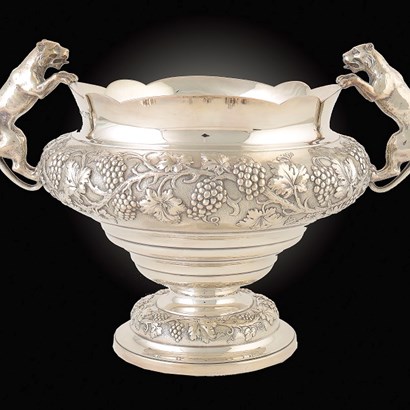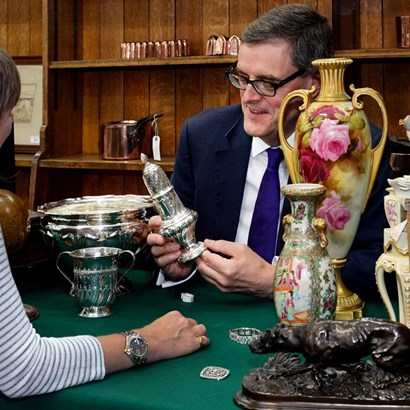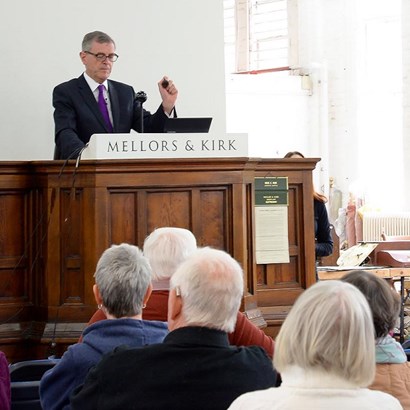Auction Insights
Ivory
As a delegate at the CITES conference in London last week it is clear there is only one subject the Art & Antiques trade is talking about.
Next week Parliament begins a consultation with key trade associations, museums and wildlife campaigners on whether to ban the sale of objects made of ivory, or that incorporate it, in the UK. ‘Quite right too’, I hear you say. Prince William and Boris Johnson to name but two, certainly think so.
The elephant is, above all other species, the most universally adored mammal. It is the de facto emblem of the African continent. In England our love for the elephant started with Jumbo, the African elephant which arrived at London Zoo in 1865, drawing enormous crowds. Over 100 years earlier the Venetian painter Pietro Longhi, in an amazing picture conveyed something of the fascination of the people for an Indian elephant when it was exhibited in the city of canals in 1774. The present law on ivory makes it illegal to advertise or sell what is known as ‘unworked’ ivory however old, or anything which was ‘worked’ or ‘reworked’ after 1946. A tusk is ‘unworked’, whereas an ivory billiard ball has been ‘worked’. Should that billiard ball have been reworked, for example into a miniature carving such as netsuke, it cannot be sold.
Very recently China, France and the USA have imposed a complete ban on ivory leading to dealers facing heavy fines, criminal records and confiscation of their stock.
The exploitation of animals for objects of art or adornment, or pseudo medicines (such as rhino horn) is, in the 21st century seen by almost all of us as repugnant, as is for so many hunting for sport. A huge recent increase in elephant and rhino poaching in impoverished African countries, corruption and the black market means iconic species such as these, are now critically endangered. A total ban, or severely curtailed trade in the UK would send a powerful message to other wealthy nations. So what is all the fuss about?
Ivory has been traded for thousands of years. It is of unique cultural and historical significance. Practically every civilisation and all the great religions have employed it for both secular and devotional objects. Until the colonial era (the 19th & early 20th centuries) it was a highly prized material used with a care bordering almost on reverence by some of the most highly skilled artists, or else by indigenous peoples who also afforded it the highest status. The problem began, in my view, in the second half of the 19th century. Britain especially, but also other countries particularly China and Japan imported colossal amounts of ivory, in the case of the former both raw tusks and worked, in the case of South East Asia mostly just raw tusks. By the 20th century this once very special material had become so ubiquitous that it was used for inexpensive jewellery and trinkets, piano keys and handles. In the 1920s & ‘30s everything from hairbrushes to cigarette boxes were made of it as were those rather decadent bronze and ivory ‘chryselephantine’ figures by Ferdinand Preiss and Demetre Chiparus which were made on a sort of production line. They may realise high prices, at least at present, but are they of real worth?
It is just these types of object that Mellors & Kirk and other auctioneers and dealers are seeing every day. There is an enormous amount of it still ‘out there’. Many clients are increasingly uneasy, even ashamed about handling it.
It has been said that this abundance of old and antique ivory objects is feeding the market in Hong Kong and elsewhere for illegal, modern poached ivory. That may be the perception but cause and effect have not been proven and it remains to be seen how effective the Chinese authorities will be in stamping out the illegal trade.
Clearly, however, major change is coming. At the CITES conference in County Hall opposite the Palace of Westminster my sense was that the overwhelming majority of the nearly 300 delegates expect it. The spectrum of views on offer ranged from since we all abhor modern poaching banning old ivory is unnecessary to those advocating a complete ban, whilst some advocate what would amount to a bureaucratic certification scheme, whereby certain specific objects get a type of passport that would enable them to be freely traded. Merely tinkering with an amendment to the existing law would be wrong because drastic measures are required and if MPs truly represent the views of their electorate either an outright ban, or much stricter controls will soon be on the statute book.
Whatever new law emerges, irrespective of Brexit, it must start from the principle that there can be no conceivable demand for ivory. It is no longer a commodity and that over the last 100/150 years it has been allowed to become one, is a shameful thing. The new law should, by greatly restricting what can be sold, restore ivory works of art to the status where everyone can appreciate the beauty of this wondrous material worked by human hands into beautiful objects, without fearing for the animals’ future. Knee jerk reactions to a crisis, and bans, in a laissez faire society usually turn out to be bad or counterproductive in the long run, so I contribute these suggestions:
- Outlawing the sale of any ivory object or others that incorporate it which were made after 1800 and are worth at (2017 prices) under £3,000. These criteria to be periodically reviewed.
- An exemption for objects which contain only a miniscule amount of ivory and that are genuine antiques, for example the tiny inlaid keyhole on an 18th century chest of drawers
- Portrait miniatures painted on ivory, if dating from before 1850 on grounds of historic significance
Such a drastic re-setting of the parameters is not the outcome most of my colleagues are hoping for but it would, at a stroke, remove practically all ivory objects from the market.
Statesmanship seems to be conspicuous by its absence in certain quarters at the present time, especially in such matters as climate change and the environment. Let’s hope our politicians set a better example than vote-grabbing populist measures, over this highly emotive subject.
If you feel strongly about this watch the debate in Parliament on February 6, or write to your MP as the Consultation Period is expected to run for the next 12 weeks.
< Back to Auction Insights



